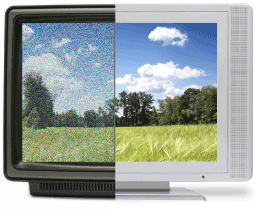Get Ready for DTV
Digital television (DTV) is an innovative new type of over-the-air broadcasting technology that enables TV stations to provide dramatically clearer pictures and better sound quality.
DTV is more efficient and more flexible than the traditional broadcast technology known as analog. For example, DTV makes it possible for stations to broadcast multiple channels of free programming simultaneously (called multicasting), instead of broadcasting only one channel at a time. DTV technology can also be used to provide future interactive video and data services that are not possible with analog technology.

What is analog television?
Analog television service is the traditional method of transmitting television signals. Analog transmission has been the standard broadcast technology since the inception of television. Analog is not as efficient as digital television: it uses up much more of the valuable spectrum than digital, and TV stations can only transmit one channel of programming with an analog signal versus up to four or more programs with a digital signal in the same amount of spectrum. Analog is also susceptible to interference and “snow” that make a picture less clear.

What is the DTV transition?
The DTV transition is the switchover from analog (the traditional method of transmitting television signals) to exclusively digital broadcasting of free television programming for all full-power television stations. The transition from analog to digital television represents the most significant advancement of television technology since color TV was introduced. The DTV transition will be completed on June 12, 2009, as set by Congress. Full-power television stations have been preparing for the transition from analog to DTV since the late 1990s, when they began building digital facilities and airing digital channels alongside regular analog broadcasts. Today, 1,624 out of 1,762 full power television stations nationwide offer digital programming.

What equipment do I need?
If you currently receive free over-the-air television programming on an analog television set, you will need a DTV converter box to continue to receive television service after June 12, 2009. DTV converter boxes will be available in early 2008. To help consumers cover the cost of the converter box, the National Telecommunications and Information Administration (NTIA) is issuing up to two converter box coupons valued at $40 each to households. Information about the DTV converter box coupon program is available at
www.ntia.doc.gov.

What is a DTV converter box?
A DTV converter box is an easy-to-install electronic device that hooks up to your analog television set and over-the-air antenna and converts the digital television signal into analog, making it viewable on your analog TV. The National Telecommunications and Information Administration (NTIA) will issue up to two converter box coupons valued at $40 each to households to help defray the cost of the converter box. To apply, or for more information, visit
www.dtv2009.gov.

